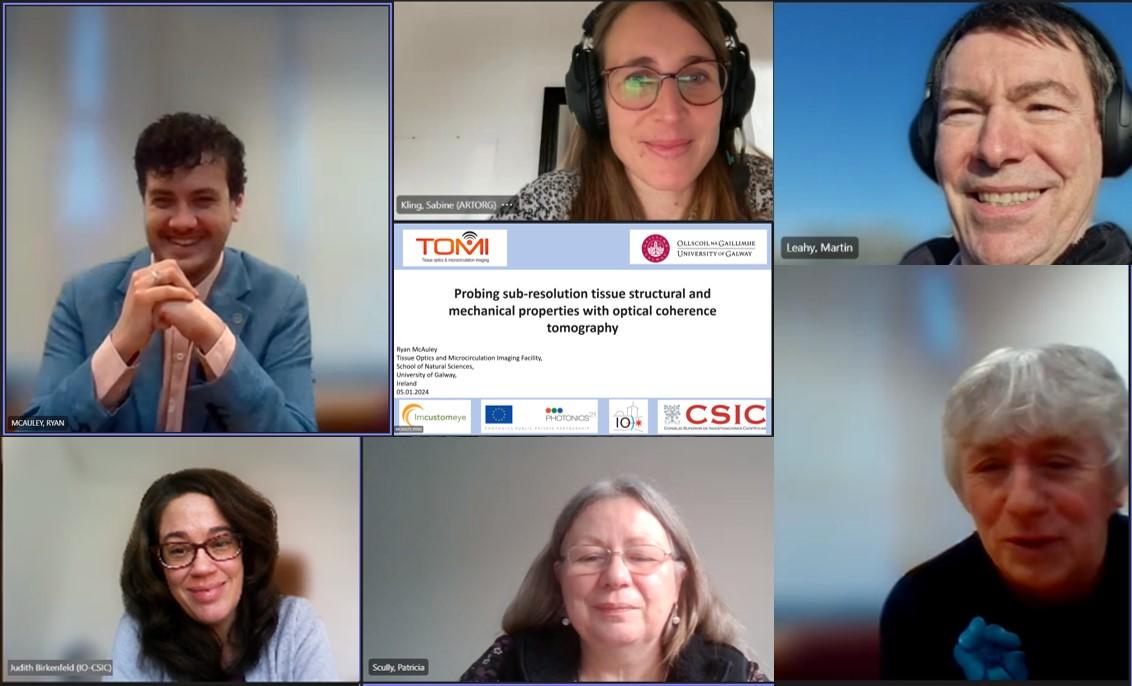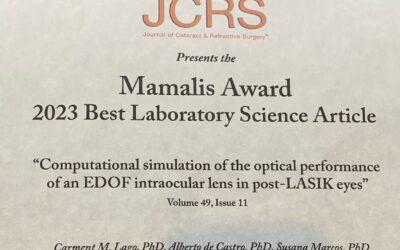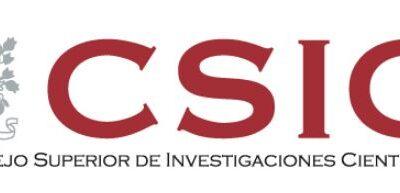Last January 5th, Ryan McAuley successfully defended his PhD thesis on ‘Probing sub-resolution tissue structural and mechanical properties with optical coherence tomography’ (Supervisors: Prof. Martin Leahy, University of Galway, Dr. Judith S. Birkenfeld, IO-CSIC; Thesis defense/Chair: Prof. Miriam Byrne, University of Galway, External examiner: Dr. Sabine Kling, ETH Zurich, Internal Examiner: Prof. Patricia Scully, University of Galway).

In his thesis, Dr. McAuley assessed sub-resolution signals related to the static and dynamic, structural and mechanical properties of tissue using vibrometric, nanosensitive, and synthetic Fourier domain extensions of OCT. The thesis includes a fruitful collaboration between the Visual Optics and Biophotonics Laboratory of IO-CSIC, and Prof. Leahy’s research group (TOMI) at the University of Galway, Ireland, based on the European H2020 Imcustomeye project. We wish Dr. McAuley all the best in his new position as a postdoctoral researcher in the research group of Prof. N. Uribe-Patarroyo at the Wellman Center for Photomedicine/Harvard Medical School.
Here is a summary of his thesis: The structural and mechanical properties of biological tissues are intimately coupled with adequate organ function and tissue health. Optical coherence tomography (OCT) is extensively used in the study of human tissues, such as the cornea, skin and tympanic membrane, owing to its impressive resolution and depth range. However, diseases often manifest as tissue alterations below the resolution limit, and therefore, conventional intensity-based OCT is of limited use for early-stage detection or diagnosis. The aim of this work is to harness the subresolution signals from OCT to understand, detect and diagnose tissues. Vibrometric, nanosensitive and synthetic Fourier domain extensions of OCT were used to access subresolution signals related to the static and dynamic, structural and mechanical properties of tissue. Demonstration examples include corneal tissue, skin and stem cell spheroids. The vibrational resonance frequency modes of six corneal phantoms and two ex vivo rabbit corneas were successfully measured with the co-axial, acoustic optical coherence vibrometry probe. The resonance frequencies of the corneal phantoms showed sensitivity to the thickness, Young’s modulus and intraocular pressure of the phantoms. The resonance frequencies of the ex vivo rabbit corneas were observed to increase with increased intraocular pressure.
Related news
EPIC Online Technology Meeting
Last week, June 3, VioBio Lab researcher María Viñas was a speaker at the EPIC (European Photonics Industry Consortium) Online Technology Meeting on...
VioBio Lab article published in Journal of Cataract & Refractive Surgery recognized with the Mamalis Award
Our study on the performance of an EDOF intraocular lens in post-LASIK eyes was selected for the Mamalis Award as the 2023 Best Laboratory Science...
Eduardo Martínez Enríquez y Víctor Rodríguez recognized in the 1st edition of the CSIC Transfer and Entrepreneurship Awards
Our colleagues Eduardo Martínez Enríquez and Víctor Rodríguez López have been awarded in different categories of the first edition of the CSIC...




